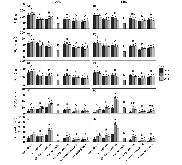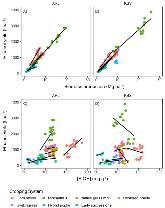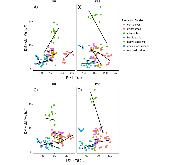Biomass Production a Stronger Driver of Cellulosic Ethanol Yield than Biomass Quality
- DOE‐Great Lakes Bioenergy Research Center Univ. of Wisconsin–Madison 1552 University Ave. Madison WI 53726, Dep. of Agronomy Univ. of Wisconsin–Madison 1575 Linden Drive Madison WI 53706
- W.K. Kellogg Biological Station Michigan State University Hickory Corners MI 49060
- DOE‐Great Lakes Bioenergy Research Center Michigan State Univ. East Lansing MI 48824, Dep. of Plant, Soil, and Microbial Sciences Michigan State Univ. East Lansing MI 48824, W.K. Kellogg Biological Station Michigan State University Hickory Corners MI 49060
- DOE‐Great Lakes Bioenergy Research Center Michigan State Univ. East Lansing MI 48824, Dep. of Plant, Soil, and Microbial Sciences Michigan State Univ. East Lansing MI 48824
Core Ideas Fermentable sugars were greatest in corn stover > perennial grasses > polycultures. Corn stover had the highest ethanol content. Miscanthus had the highest ethanol yield potential on a per hectare basis. Ethanol yield potential per hectare of switchgrass ≥ corn stover. Biomass yield was the strongest driver of per hectare ethanol yield. Many crops have been proposed as feedstocks for the emerging cellulosic ethanol industry, but information is lacking about the relative importance of feedstock production and quality. We compared yield and sugar content for seven bioenergy cropping systems in south‐central Wisconsin (ARL) and southwestern Michigan (KBS) during three growing seasons (2012 through 2014). The cropping systems were (i) continuous corn stover ( Zea mays L.), (ii) switchgrass ( Panicum virgatum L.), (iii) giant miscanthus ( Miscanthus × giganteus Greef & Deuter ex Hodkinson & Renvoize), (iv) hybrid poplar ( Populus nigra × P. maximowiczii A. Henry ‘NM6’), (v) native grass mix, (vi) early successional community, and (vii) restored prairie. A high‐throughput pretreatment and fermentation assay showed corn stover with the highest sugar content (213 g glucose kg −1 [Glc] and 115 g xylose kg −1 [Xyl]) followed by the two monoculture perennial grass treatments (154 [Glc] and 88 [Xyl]) and then the herbaceous polycultures (135 [Glc] and 77 [Xyl]). Biomass production and sugar content were combined to calculate ethanol yields. Miscanthus had the highest per hectare ethanol yields (1957 l ha −1 yr −1 ARL, 2485 l ha −1 yr −1 KBS) followed by switchgrass (1091 l ha −1 yr −1 ARL, 1017 l ha −1 yr −1 KBS) and corn stover (1121 l ha −1 yr −1 ARL, 878 l ha −1 yr −1 KBS). Perennial grass cropping systems (i.e., switchgrass and miscanthus) had higher per hectare ethanol yields at both sites relative to diverse systems that included dicots. Despite feedstock differences in fermentable sugars, biomass production was the strongest driver of per hectare ethanol yield.
- Research Organization:
- Univ. of Wisconsin, Madison, WI (United States)
- Sponsoring Organization:
- USDOE Office of Energy Efficiency and Renewable Energy (EERE); National Science Foundation (NSF); USDOE Office of Science (SC), Biological and Environmental Research (BER)
- Grant/Contract Number:
- FC02-07ER64494; AC05-76RL01830
- OSTI ID:
- 1826808
- Alternate ID(s):
- OSTI ID: 1418642
- Journal Information:
- Agronomy Journal, Journal Name: Agronomy Journal Vol. 109 Journal Issue: 5; ISSN 0002-1962
- Publisher:
- Wiley Blackwell (John Wiley & Sons)Copyright Statement
- Country of Publication:
- United States
- Language:
- English
Web of Science
Similar Records
Nitrous oxide emissions during establishment of eight alternative cellulosic bioenergy cropping systems in the North Central United States
Data from: Nitrous oxide emissions during establishment of eight alternative cellulosic bioenergy cropping systems in the North Central United States




